Distribution Search Result
Distribution Search Result
When you've entered in your filters and pressed the Search button, the Distribution Search Result screen will be shown. This presents you with a list of distributions, tabbed by document type.
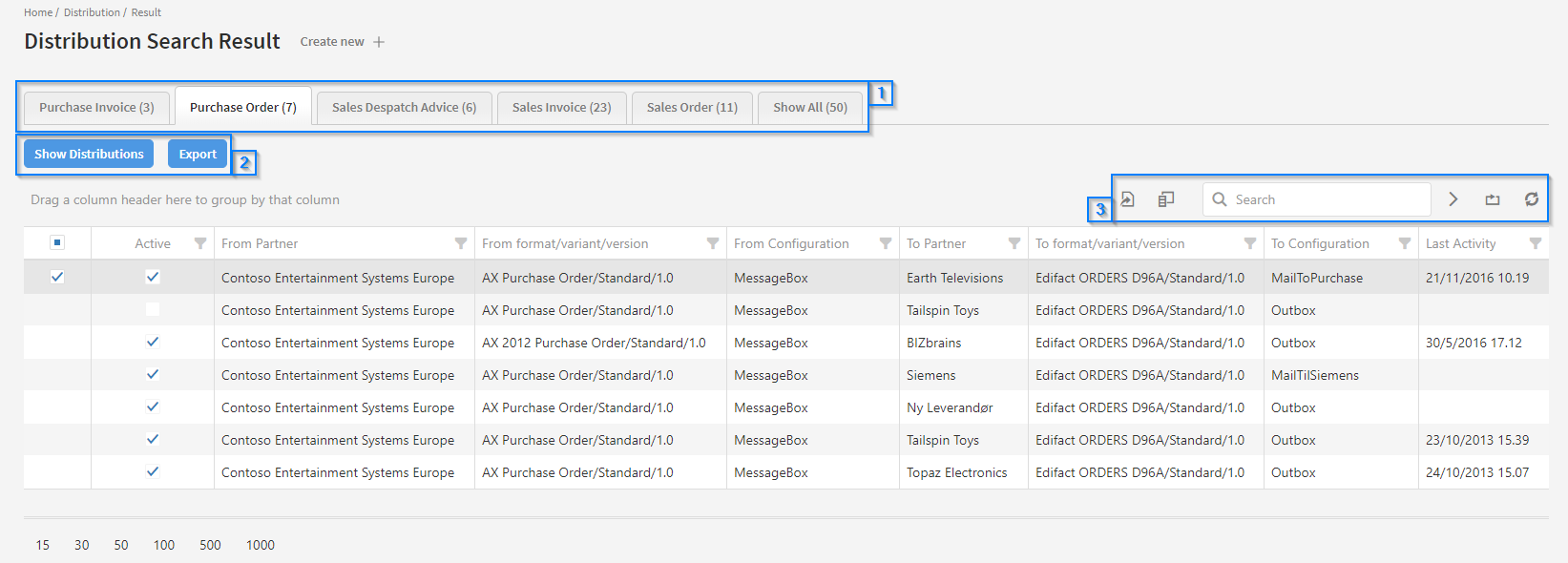
Depending on the filters you set earlier, you may only have a single tab. As an example here, we have searched for Distributions, where "Contoso Entertainment Systems Europe" is either the To or From partner.
Each element on the Distribution Search Result page will be explained in detail below.
Create new
At the top of the page you have the option to create a new distribution. Clicking this will redirect you to the 'New Distribution' page. How to create a distribution is described on the 'Create New Distribution' page in this user guide.
Document Type Tabs [1]
Here you can select the document type of the distributions that should be shown in the list. If your search resulted in more than one document type, they will all be available from here. Select the 'Show All' tab to get a list of distributions across all document types.
Action Buttons [2]

These buttons allow you to perform an action on the currently selected distribution(s). To select a distribution, you must tick the checkbox that appear when you hover your mouse in the leftmost column as shown below.
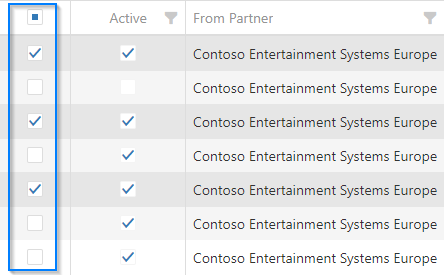
Show Distributions
Clicking this will redirect you to a more detailed view of the distributions that were selected. This is explained on the 'Distribution Search Details' page in the user guide. If you just want to see the details of a single distribution, you can also double click the distribution in the data grid to be redirected.
Export
Press this button to download the raw data of the selected distributions in XML format. Selecting more than one distribution will batch the data into a single XML file.
Data Handling [3]

While the action buttons allow you to perform actions on selected distributions, these options allow you to perform actions on the entire data grid. These will be further detailed below in order from left to right.
Export
Clicking the export button will present you with a dropdown of two options:
- Export all data
- Export selected rows
These allow you to either export the entire data grid as it is presented, or a specific set of rows. To select a row, click the empty checkbox in the furthest left column. You can deselect a row by clicking it again.
Unlike the 'Export' action explained in the 'Action Buttons' section, this will download the data grid itself as an .xslt file, which can then be opened in an Excel program.
Column Chooser
This option makes it possible to customize which columns should be displayed in the data grid. Some columns are selected by default. When selecting it, you will be presented with a small window that contains all the columns that are not currently in use.
You can scroll while hovering your mouse over window box to see additional columns. To insert a new column you must drag it from the window to to the data grid. A blue line will appear when dragging, which means the column will be placed between the two columns. You can drag any column back to the window in the same manner. See the animation below for further reference.
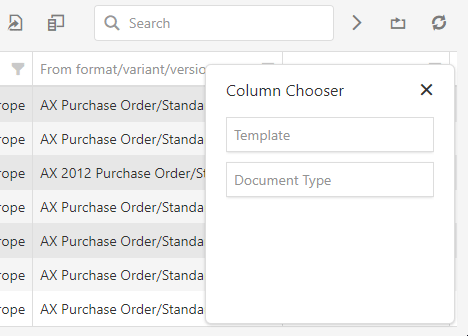
Search
When the data grid become too large, you may need to search for a specific distribution. The search box will perform its search on the entire data grid and will exclude the rows that do not match the search dynamically. Note that it is not possible to search for specific dates and time intervals. Press the 'x' next to the search term to reset the search.
Reset
Clicking this will reset the state of the grid to the default state. This means that all current sorting, grouping, filtering etc. will be reset. If you have placed or removed any columns via the column chooser, these will be reset as well. Any currently selected rows will be deselected.
Collapse / Expand
Mangler tekst
Refresh
This will refresh the data grid, which may allow new distributions to show up or remove ones that no longer meet the search criteria.
Right-Click Actions
When selecting one or more distributions, you can right click anywhere in the grid to have a list of actions be displayed. Note that some of these actions are only available when selecting a single distribution.
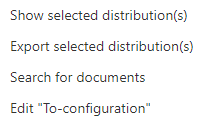
Each of these actions will be explained in detail below.
Show selected distribution(s)
This will redirect you to the 'Distribution Search Details' page for the selected distribution(s). There you can see additional information about the distribution. This has the same functionality as the 'Show Distributions' button.
Export selected distribution(s)
Clicking this will export the selected distribution(s) to your local hard drive. It has the same functionality as the 'Export' button.
Search for documents
Press this to be shown a list of all documents that have used this distribution in Link. You will be redirected to the 'Tracking Search Result' page. Use this as a shortcut to quickly find documents for a given distribution. Note that this action is only available if a single distribution is selected.
Edit "To-configuration"
Click this to open up the 'Locations' tab for the To partner. There you can edit what transport type is being used by the partner. See the 'Locations' page in the user guide for more details. Note that this action is only available if a single distribution is selected.
Data Grid
The data grid contains all the data that matched your search divided into rows. Each row represents one distribution. To see further detail about a distribution, you can also double click it on the data grid, which will take you to the 'Distribution Search Details' screen, which is described on its own seperate page in the user guide.
There are several functions available on the data grid itself. These will be explained in more detail below.
Sorting
To sort the data, simply click on the column you wish to sort by. The first sorting done when clicked will be in ascending order. Click the column again to sort in descending order.
Grouping
Organizing data in groups can help you get a quick overview of your data set. To group your data, drag the desired column into the small space above the data grid, where this text is displayed: "Drag a column header here to group by that column". See the animation below for further reference.
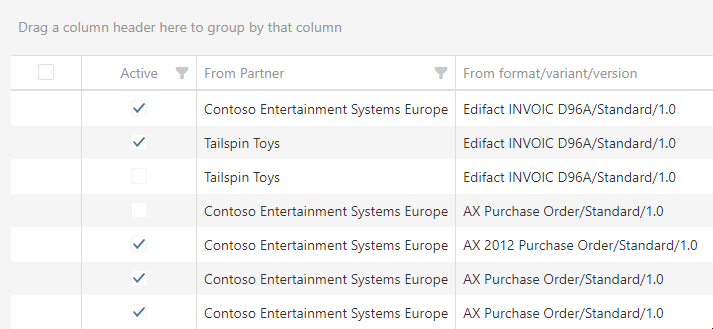
After you have dragged and released the column, a new window will appear, showing how many distributions match each group. In the example animation above, we have grouped by 'From Partner', which will group the distributions by the sender party. Click the small arrow to the left to expand each group and see the individual distributions. You can sort the groups by clicking on the group header.
To add more groups, simply use the same drag and drop method as explained. Each group will then contain several subgroups depending on how many groups you selected.
To return to the standard data grid, you can either drag the groups back onto the data grid, or click the 'Reset' button, which is explained in the 'Data Handling' section on this page.
Filtering
In order to exclude certain rows from the data grid you can make use of filtering. The filtering option is located to the right of the column name. By clicking it a window will appear, which show you the different values for the selected column. Click the checkbox next to the value to filter by it. 'Select All' will filter by all the values. See the animation below for further reference.
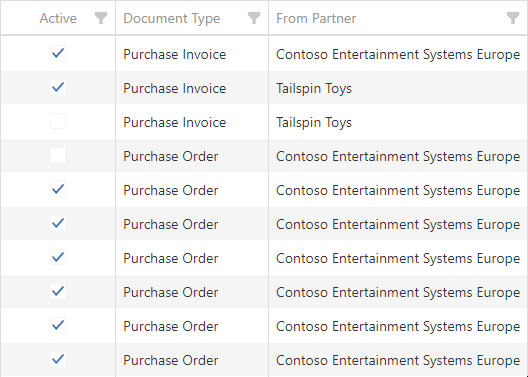
You can go back and change your filtering options, by clicking the filter icon again. To filter by more than one column, simply select the filter icon for each column you wish to filter by.
To reset the filtering, you can open the filtering options for each column and remove the checkboxes. Alternatively you can reset the entire data grid using the 'Reset' button, which is explained in the 'Data Handling' section on this page.
Pagination
When you are dealing with a large amount of distributions, the data may need to be split up into several pages. At the bottom left of the data grid you have the option to choose the number of distributions that should be displayed on a single page. You can display from 15 up to 1000 distributions on a single page.

You can navigate between pages in the bottom right of the data grid.

Content on this page:
